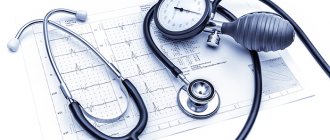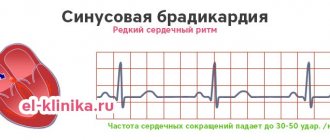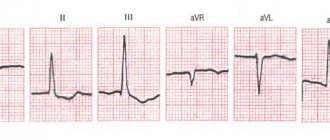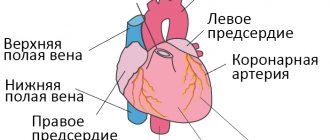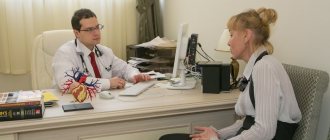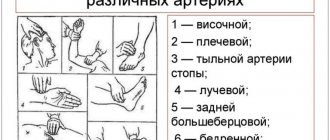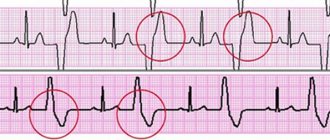Are rapid heartbeats, chest pain and shortness of breath preventing you from living a full life? Arrhythmia may be the cause of your discomfort. Arrhythmia is disturbances in heart rhythm that occur as a result of other disorders in the body.
The normal heart rate for a person under the age of 60 is 60-80 beats per minute. The heart muscle contracts at regular intervals, so a person gets used to it and does not notice his heartbeat. Deviations from the norm are accompanied by a rapid pulse and irregular contractions. Or it may be completely asymptomatic. Therefore, the presence of arrhythmia and its type can only be determined using instrumental diagnostics. Arrhythmia occurs more often in men over 60 years of age. However, in rare cases it also occurs in children.
Why is arrhythmia dangerous?
The disease occurs as a result of disturbances in the conduction system of the heart, which ensures sinus rhythm - regular contractions of the myocardium. Contractions of the heart muscle originate in the sinus node and spread through the myocardium of the right atrium to the atrioventricular node. It turns out to be less excitable, so the atria contract first, only then the ventricles. Without timely diagnosis and treatment, arrhythmia causes angina attacks, heart failure, pulmonary edema and even cardiac arrest.
Causes of cardiac arrhythmia.
The disease occurs both as a result of other cardiac pathologies and for reasons not related to the functioning of the heart. The first group includes:
- cardiac ischemia;
- previous myocardial infarction;
- cardiomyopathy (changes in the size and shape of the heart);
- congenital and acquired heart defects;
- myocarditis (inflammatory diseases of the heart muscle);
- arterial hypertension;
- injuries and wounds of the heart, including surgical ones;
- heart failure;
- cardiosclerosis.
As a result of these diseases, the heart muscle is damaged. The conduction system of the heart suffers, and the normal propagation of the electrical impulse of the heart to its various parts becomes more difficult. Sometimes the lesion affects the sinus node.
Arrhythmia can also be caused by:
- vegetative-vascular dystonia;
- tobacco and alcohol abuse, intoxication;
- heavy or excessive physical activity;
- febrile conditions in infectious diseases;
- disorders in the endocrine system;
- the influence of stress, the presence of neuroses;
- exhausting mental or physical work;
- metabolic disorders of electrolytes important for the heart (potassium, magnesium, sodium, calcium).
As a result of the influence of these factors, defects form in the heart muscle, due to which it cannot function normally and conduct electrical impulses along damaged nerve branches.
Sinus arrhythmia in children and adults
SA is more often a disease of young people: children, teenagers.
And also those who regularly engage in sports in intense, hard training. In this case, the deviation of the heart rate can persist for quite a long time - for days, weeks, months. In children and teenagers this goes away on its own, but in athletes it can persist forever. But SA can also occur in a number of pathologies.
Such as myocardial infarction, stroke, pneumonia, acute respiratory viral disease, pancreatitis, etc. In this case, this rhythm disturbance is also secondary and goes away as the underlying pathology is cured. Sometimes SA is a manifestation of a vegetative “imbalance” of the body, which occurs in a number of situations, or is congenital. Remember one thing
. Normally, each of us goes through growing up, faces emotional, physical stress, and illness, but not always, not everyone is accompanied by the development of sinus arrhythmia.
Symptoms of cardiac arrhythmia:
- Weakness, accompanied by dizziness, absent-mindedness, drowsiness and headaches. It appears in cases where special efforts are required to perform some action.
- Rapid heartbeat, which feels like a “thrill,” the heart is pounding or “jumping out of the chest.” May be accompanied by strong pulsation in the neck, temples, fingertips, tinnitus and difficulty breathing.
- Pain in the chest, behind the sternum. It can be aching, stabbing, burning. Accompanied by difficulty breathing, cold sweat, and nausea.
- Dyspnea. Breathing becomes frequent and noisy. If shortness of breath occurs at rest or with slight physical exertion, its nature is pathological. It is cardiovascular diseases that lead to insufficient blood circulation. The organs do not receive the required amount of oxygen and accumulate carbon dioxide. Internal organs do not receive the required amount of oxygen. This causes shortness of breath.
Normal ECG findings in athletes: recognizing physiological adaptations
A large international team of experts presented an article - one of a number of detailed methodological explanations of the practice of applying the so-called “Seattle Criterion”. The criterion is intended to facilitate the task of early diagnosis of cardiovascular system disorders in athletes using a 12-channel electrocardiograph.
The work is devoted to those unusual signs that in an ordinary person may indicate the development of conditions leading to a sudden heart attack, but in the case of athletes they only reflect the normal adaptive processes that occur in the body under the influence of regular physical activity. The authors hope that taking these processes into account will avoid many additional pointless studies of athletes and unjustified restrictions on the training and competitive processes.
Up to 60% of athletes demonstrate such changes on cardiograms (individually or combined) as:
- sinus bradycardia
Types of arrhythmia:
Atrial fibrillation.
An abnormal heart rhythm during which the atria contract faster than the ventricles. This is a complication due to coronary heart disease. Diseases of the endocrine system can also cause the development of atrial fibrillation. Unlike normal heartbeat, muscle fibers in atrial fibrillation are excited frequently and chaotically. In addition to frequent contractions of the heart muscle, the disease is accompanied by increased sweating, darkening of the eyes, muscle weakness and fainting.
Sinus arrhythmia.
During the disease, the sinus node, the main “engine” of impulses in the heart, is damaged. Because of this, the sinus node begins to malfunction. With sinus arrhythmia, an alternation of rapid and slow rhythm occurs. A common type of sinus arrhythmia occurs, in which during inhalation the heart rate increases, and when exhaling, on the contrary, it decreases. This disease is also called respiratory arrhythmia. The pathology is accompanied by dizziness, severe fatigue, breathing problems, and loss of consciousness.
Atrial flutter.
This is a rapid atrial rhythm, reaching 200-400 beats per minute. The reasons for the deviation may be complications after other cardiovascular diseases, the postoperative period, severe stress, or pathological processes in the body. Accompanied by symptoms such as general weakness, discomfort in the chest or behind the sternum, shortness of breath and sudden attacks of rapid heartbeat.
Heart rhythm disturbances
Cardiac arrhythmias are changes in the normal rate, regularity, and source of excitation of the heart, as well as disturbances in the communication between the activation of the atria and ventricles. Such disorders occur not only in patients, but also in healthy people, in particular athletes, quite often. In recent years there have been significantly more of them.
The need to study them is determined by the fact that a number of arrhythmias represent an early and, perhaps, the only sign of prenosological forms of heart disease. This dictates the need for their careful analysis.
Electrophysiological and pathogenetic mechanisms, clinical manifestations and ECG patterns of cardiac arrhythmias are diverse and include a wide range of options from clinically insignificant disorders to disorders that pose an immediate threat to life.
According to the severity of manifestations and clinical significance, all cardiac arrhythmias can be divided into “large” and “small”. “Major arrhythmias”, the clinical significance of which is great, include frequent and early extrasystoles, paroxysmal tachycardia. advanced atrioventricular block, atrial fibrillation and flutter, etc. Most domestic and foreign monographs on cardiac arrhythmias are devoted to the analysis of such arrhythmias.
“Small arrhythmias” include sinus bradycardia, sinus arrhythmia, polyfocal pacemaker, rare extrasystoles, escape contractions, etc. In clinical cardiology, they receive much less attention, since they often occur in healthy people and can be considered as a normal variant.
Currently, it is generally accepted to divide arrhythmias into 3 main groups depending on the electrophysiological mechanisms of their development. These are disturbances in the formation of impulses, disturbances in the conduction of impulses, and combined disorders in the formation and conduction of impulses. These groups of arrhythmias form the basis of the clinical-pathogenetic classification proposed by M. S. Kushakovsky (1974, 1981), which we used in the analysis of rhythm disturbances in athletes and healthy young people not involved in sports.
The diagnostic criteria for some variants of arrhythmias require clarification. This primarily applies to the group of arrhythmias associated with impaired impulse formation, among which arrhythmias caused by disorders of automaticity are especially frequent.
According to our data, which is generally consistent with the literature, violations of automaticity should include cases such as pronounced sinus bradycardia (R—Rcp>l.30 s, heart rate 85 per 1 min), pronounced sinus arrhythmia - cases where the value of ΔR -R=0.50 s.
The existence of a close connection between the state of activity of the sinus and ectopic pacemakers of the heart allows all cases of automaticity disorders occurring in healthy young people to be divided according to the mechanism of their occurrence into 3 groups:
1) arrhythmias occurring with increased activity of the sinus or ectopic driver; these include sinus tachycardia. pronounced sinus arrhythmia caused by a transient increase in the activity of the sinus node, a polyfocal active type pacemaker and ectopic tachycardia; this group of arrhythmias should be called disorders of active type automaticity;
2) arrhythmias occurring with normal activity of the sinus node; this is a pronounced sinus arrhythmia, as well as an ectopic and polyfocal pacemaker with an impulse frequency close to the normal sinus rhythm frequency; these are violations of automatism of the normosystolic type;
3) arrhythmias occurring with decreased activity of the sinus node, with or without manifestations of passive heterotopia. This group of arrhythmias includes pronounced sinus bradycardia, pronounced sinus arrhythmia caused by transient inhibition of the activity of the sinus node, with or without escape contractions, a polyfocal passive type pacemaker, atrial rhythm with bradysystole, atrioventricular dissociation caused by low automaticity of the sinus node. These are violations of automaticity of the passive type.
The most likely cause of the development of arrhythmias of the latter type in healthy young people is excessive inhibition (suppression) of the activity of the sinus node. This allows us to combine them into one ECG syndrome - suppressed sinus node syndrome. Despite the external similarity of the arrhythmias attributed to it with the arrhythmias of sick sinus syndrome, the identification of this syndrome is advisable, since it makes it possible to distinguish pathological arrhythmias associated with organic changes in the sinus node and more often found in people of older age groups, from arrhythmias caused only by a violation autonomic regulation, which often appears in young people.
Diagnosis of arrhythmia.
If you suspect an arrhythmia, you need to consult a specialist for examination and diagnosis to confirm or refute the diagnosis. A cardiologist examines and treats arrhythmias. Arrhythmia is a dangerous disease, so you should never self-medicate. Any medications can only be prescribed by a doctor. The drug itself, if taken incorrectly, can cause arrhythmia attacks.
At the initial appointment with a cardiologist, the doctor will ask questions about symptoms and the frequency of their manifestations, listen to the heart and measure the pulse. It is important to provide your entire medical history to your doctor. To find out the causes of arrhythmia, you will need to undergo basic tests:
- blood chemistry;
- blood test for clotting.
For further research and to exclude more serious pathologies, you will undergo an instrumental diagnostic study.
